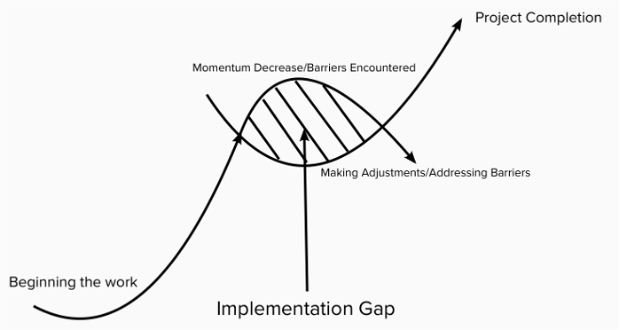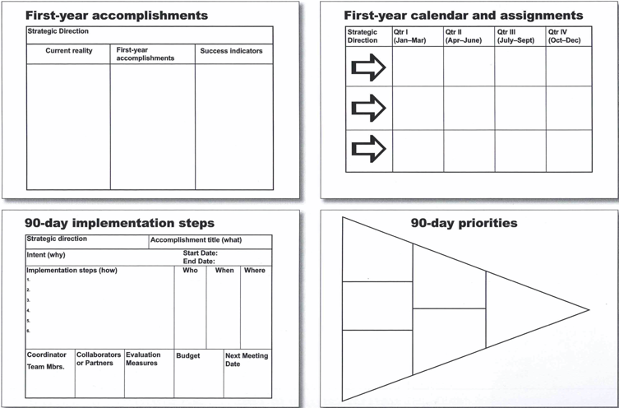
Photo courtesy of Pexels/The Lazy Artist Gallery
“Creativity is thinking up new things. Innovation is doing new things… A powerful new idea can kick around unused for years, not because its merits are not recognized, but because nobody has assumed responsibility for converting it from words into action. Ideas are useless unless used. The proof of their value is only in their implementation.” – Theodore Leavitt
You’ve completed the strategic planning process. Now what? How do you ensure the plan doesn’t collect dust on a shelf or get filed away on your computer never to be viewed again? The first step is recognizing the implementation gap is a very real phenomenon. The second is arming you and your team with the tools and resources necessary to overcome it.
The implementation gap, represented by this diagram, is the difference between goals and outputs on paper (e.g., developing a practical vision, identifying underlying contradictions, and creating strategic directions) and how they are carried out in practice (e.g., documenting the decisions made and initiating focused implementation).

A Four Dimensional Model of the Implementation Journey introduced in the Technology of Participation (ToP) Secrets of Implementation Course
Often, immediately following the planning efforts (either in-person or virtual), there’s a small dip in energy and motivation as the work begins. This is because the reality of what’s piled up as we’ve been out of the office or away from our desks sets in. Our attention necessarily turns to urgent communications, impending deadlines, existing workloads, and the like.
But, eventually, things level out and some version of balance is restored. We’re even able to find some dedicated chunks of time where we can turn back to the strategic plan in regular intervals and, more specifically, our assigned action items. This is where we begin to pick up momentum and see small, measured wins over time.
It’s not long, however, before we encounter barriers of all shapes and sizes that slow momentum. We’re waiting for folks to get back to us, a decision-maker is out of the office, some work must be completed before other work can begin, other projects become more urgent, and deadlines are pushed. Given the data currently available to us, we make adjustments and address barriers to the best of our ability.
These course corrections are generally needed several times over the course of a strategic plan’s implementation. The team’s ability to overcome the obstacle and get back on track is directly tied to how quickly they respond and how nimble the solutions. As momentum is restored, a group continues forward toward plan completion.
These four curated implementation tools are designed to help groups proactively overcome the implementation gap once their strategic directions, initiatives, or pillars are adopted. They include:
- First-year accomplishments — designed to capture the positive and negative factors from the current reality that will affect implementation, the measurable accomplishments that are desired in the coming 12 months, and the measurable outcomes that will indicate success two years from now.
- First-year calendar and assignments — the first-year accomplishments from the previous step are mapped out over a period of 12 months, additional milestones are added to fill in identified gaps, and assignments are made among team members.
- 90-day implementation steps — an incredibly detailed game plan (or sprint) created every 90 days outlining the specifics for how the work is to be completed. At the end of 90 days, team members should reconvene and review what’s completed. New 90-day implementation steps should then be drafted to account for outstanding tasks, as well as the next quarter’s actions.
- 90-day priorities — many teams find it helpful to have a visual representation of the six most important actions to be completed each 90 days. This helps to focus the team’s attention on key priorities, while also funneling limited resources into the most catalytic actions that could unblock subsequent tasks.

A Four Step Model of the Focused Implementation Workshop introduced in the Technology of Participation (ToP) Strategic Planning Course
While the completion of these four steps provides a clear roadmap, the best-laid plans often go awry. Once the reality sets in that the facilitation team has concluded their engagement with your organization, and the staff and volunteers are now charged with this long-term responsibility of seeing the plan through to completion, you’ll want some recommendations in your back pocket for building and sustaining momentum, as well as quickly course correcting, as needed.
Following are 10 such practical ideas for overcoming the implementation gap:
- Draft and disseminate the documentation quickly. The documentation should include pictures of the work product, transcriptions of the flip charts/sticky walls, and a reminder of who participated in the planning. Documentation for a full strategic plan should be drafted and disseminated to those in attendance, as well as any additional stakeholders with appropriate orientation to the materials, within a week of the session.
- Share a small physical token of the summarized plan. I often find it valuable to design and frame an incredibly succinct summary of the plan with key words/phrases, intentionally selected icons, and a picture of the planning group. This physical token can be placed on a desk or in a workspace as a constant reminder of the shared end goal.
- Move the plan into a project management platform. The time starts ticking down on the first 90-day sprint the moment the strategic planning session concludes. It’s recommended that all actionable tasks, responsible parties, and due dates are moved into a centralized project management platform within a week (two at most) of receiving the documentation.
- Create a simple dashboard to monitor progress. You’ll likely want to report out to your board and/or staff during regularly scheduled meetings which strategic directions/initiatives are gaining traction (green), which are experiencing some setbacks/slowdowns (yellow), and which have encountered major hurdles (red). These results can then serve as the basis for a sound discussion at any time about what’s going well, what needs attention, and next steps/action items.
- Schedule regular communication reminders. If your project management platform offers automated reminders, be sure to optimize them. Similarly, if you use a communication tool like Slack, schedule weekly reminders to review, prioritize, and take action on outstanding tasks. Finally, don’t underestimate the power of your Outlook calendar.
- Block dedicated implementation time each week. It’s important that the strategic plan be treated like another program, product, or service. The only way work is going to get done on the plan is for the team charged with implementation to schedule an appropriate amount of time each week (even 30 minutes would make a big difference!) dedicated to completing assigned tasks. Over the course of a 90-day sprint, that would equal six hours of implementation time per team member.
- Celebrate the wins and support the setbacks. However your team has decided to celebrate wins (several teams I work with have integrated apps into Slack for this purpose), be sure to leverage these existing communication channels. But also reinforce wins during one-on-one meetings, staff meetings, board meetings, and the like. Conversely, be prepared to swiftly deploy resources to team members experiencing setbacks, as this is an inevitable part of implementation.
- Identify a project manager who’s great at monitoring details. In groups I work with, the CEO is often selected as the default project manager when it comes to the strategic plan. But for many organizations, this isn’t the person most familiar with the project management software or most in the weeds on a day-to-day basis. Consider partnering a senior staff member with another team member for whom details are their passion.
- Ensure the plan is represented on all meeting agendas. Be it board agendas, staff agendas, or one-on-one agendas, be sure the strategic plan is embedded into the fabric of your meetings. This will signal its importance, ensure it remains on the top of everyone’s minds, and should compel regular action on tasks outside of meetings. In some instances, you may even reformat the agendas to better align with your strategic directions or 90-day priorities.
- Use the plan as a decision-making tool. In much the same way that Bill Paxton and Helen Hunt anchor themselves to the well in the movie Twister, future decisions should be made through the lens of the strategic plan. This includes what to start, stop, or maintain; how to invest limited financial resources; and how to organize staff and volunteer positions.
If you or your team has a practical idea for overcoming the implementation gap, please share with us your tips, tricks, and recommendations using the comments below or by emailing us at [email protected].


